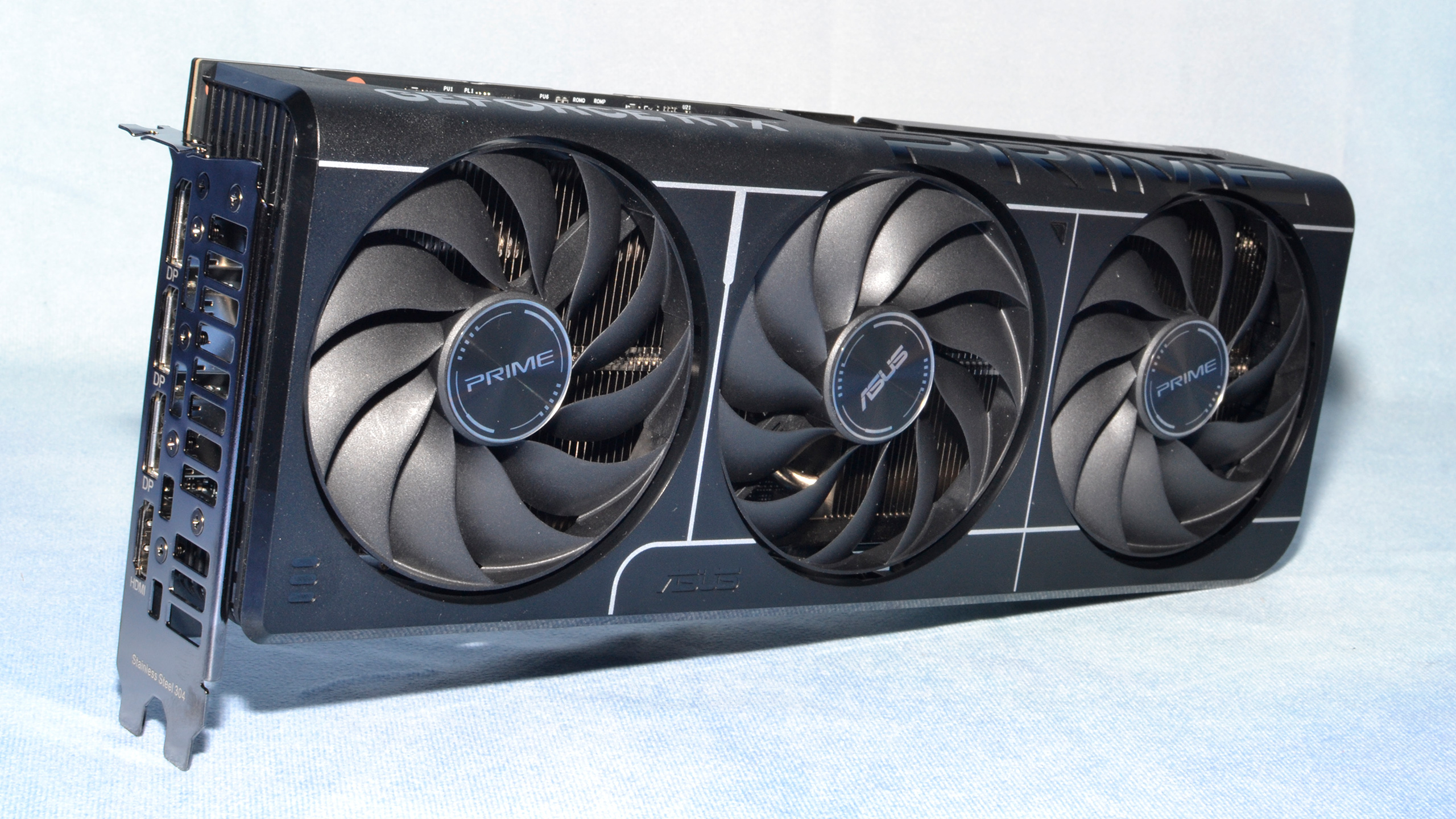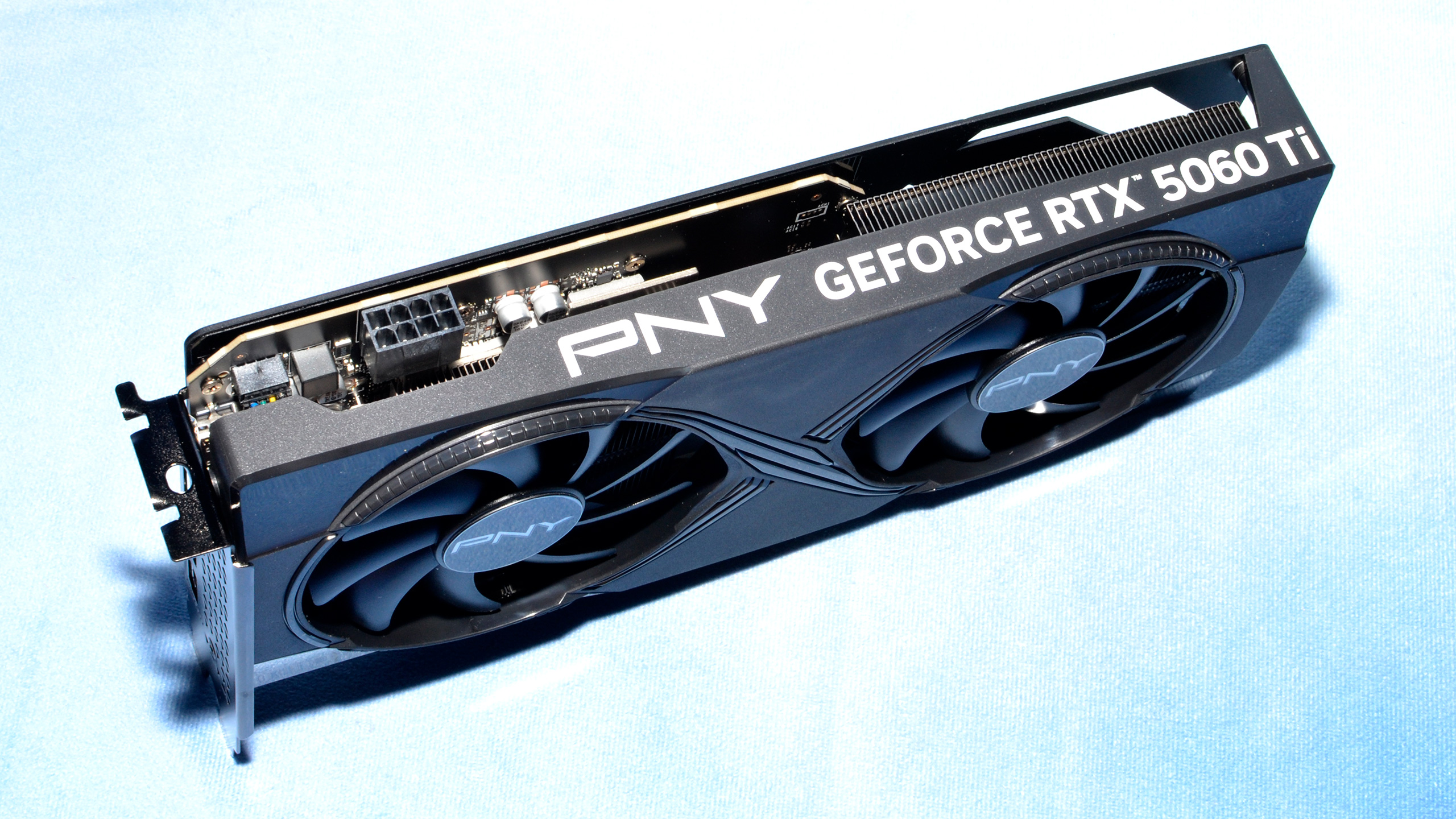Why you can trust Tom's Hardware
Nvidia GeForce RTX 5060 Ti 16GB Power, Clocks, Temps, and Noise
All our gaming tests are conducted using an Nvidia PCAT v2 device, which allows us to capture total graphics card power, GPU clocks, GPU temperatures, and some other data as we run each gaming benchmark. We have separate 1080p, 1440p, and 4K results for each area, which we'll order from highest to lowest resolution for these tests.
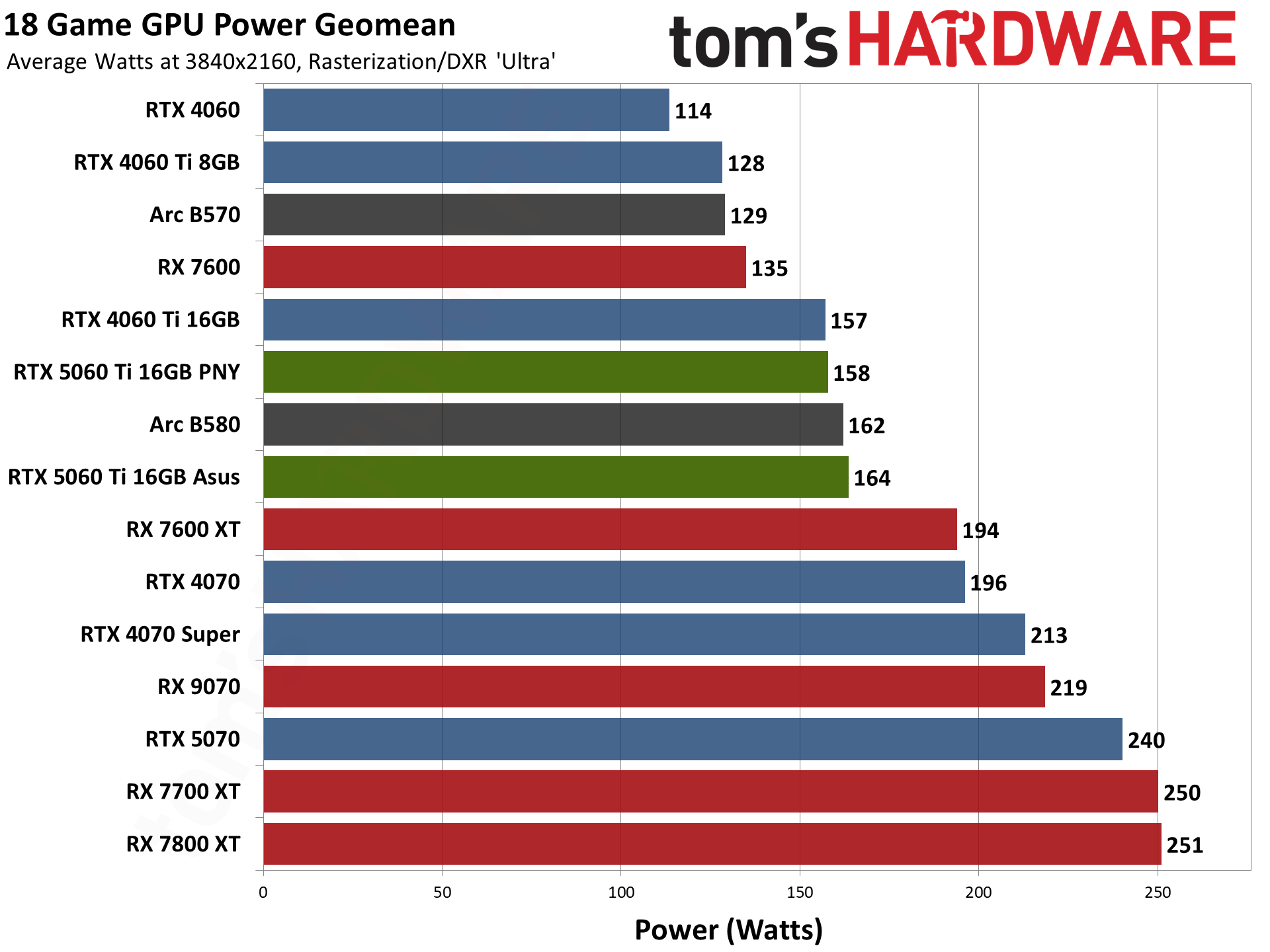
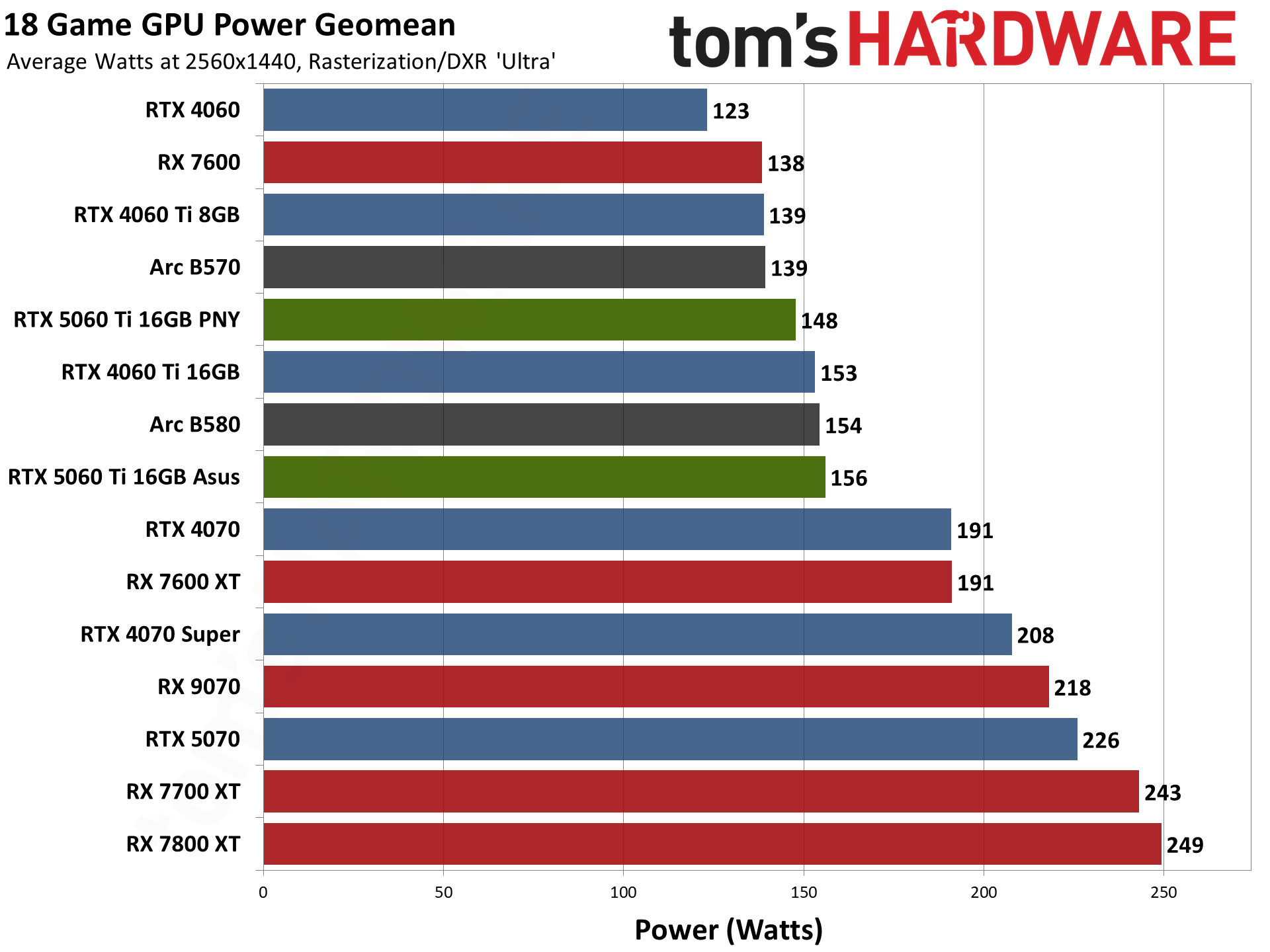

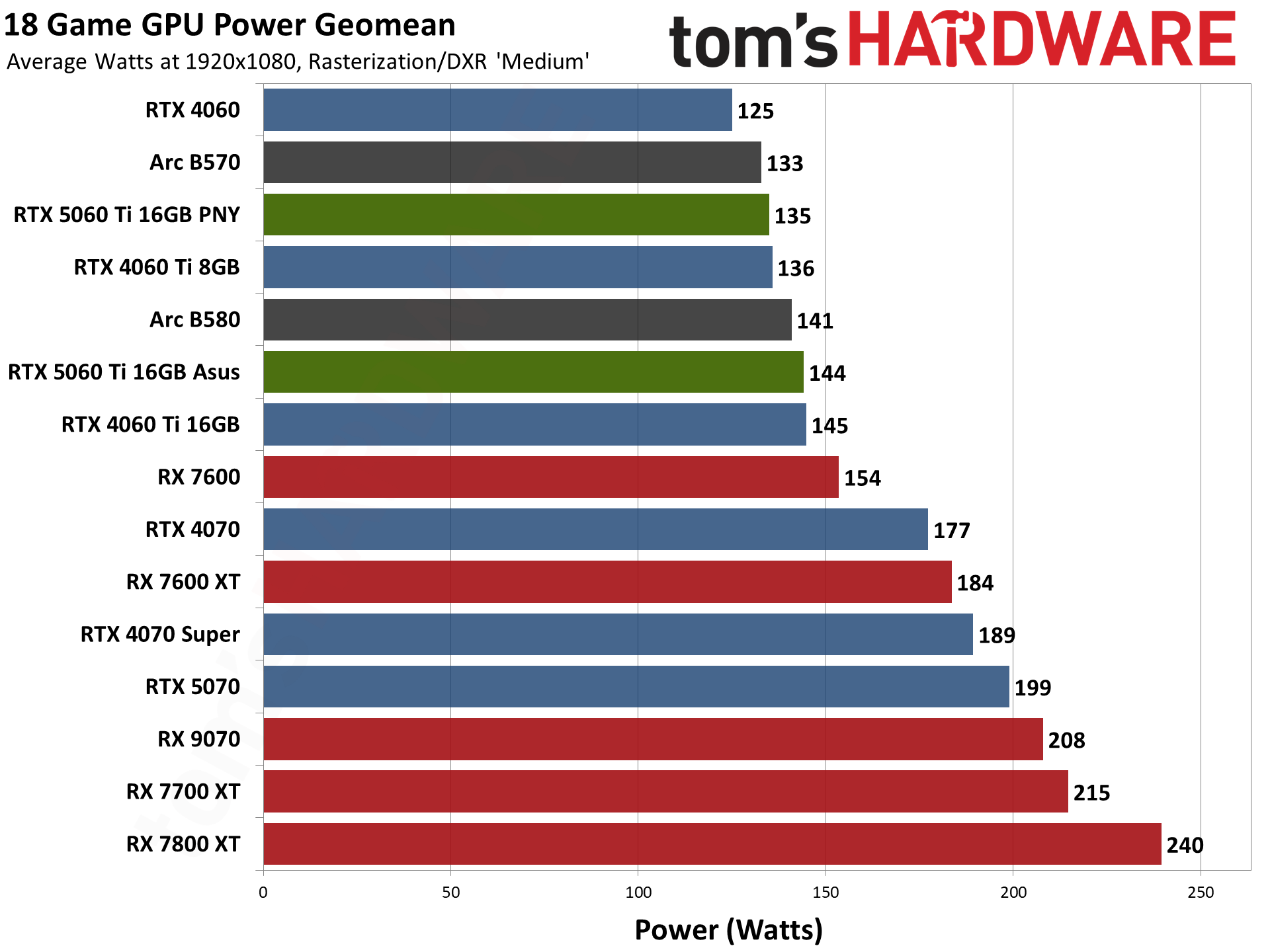
The raw specs say that Nvidia increased the power limit for the 5060 Ti by 20W compared to the 4060 Ti. Across our full gaming suite, however, the difference ends up being pretty negligible. The PNY card uses 1W more than the 4060 Ti 16GB at 4K, but 5W less at 1440p, and 9–10 watts less at 1080p. The Asus card on the other hand uses 6–9 watts more power than the PNY card, and basically ties or uses slightly more power than the 4060 Ti 16GB.
The 4060 Ti 8GB uses a lot less power at 4K, but that's because the GPU ends up waiting on the VRAM a lot of the time. At 1440p, it uses 14W less, and 9W less at 1080p.
One of the things Nvidia said it worked on with all Blackwell RTX 50-series GPUs was to improve power savings. That shows up nicely here, particularly with the lighter, lower resolution tests. The 5060 Ti 16GB is able to enter and exit sleep states quicker, giving some decent efficiency improvements.
AMD doesn't really have anything that competes directly with the 5060 Ti 16GB for now, as the 7600 XT and 7700 XT are both previous generation parts. As far as we know, neither one is still in active production, and there's no RDNA 4 option for the $380~$430 price range yet. That will come with the RX 9060 XT in the coming days (or weeks or months).
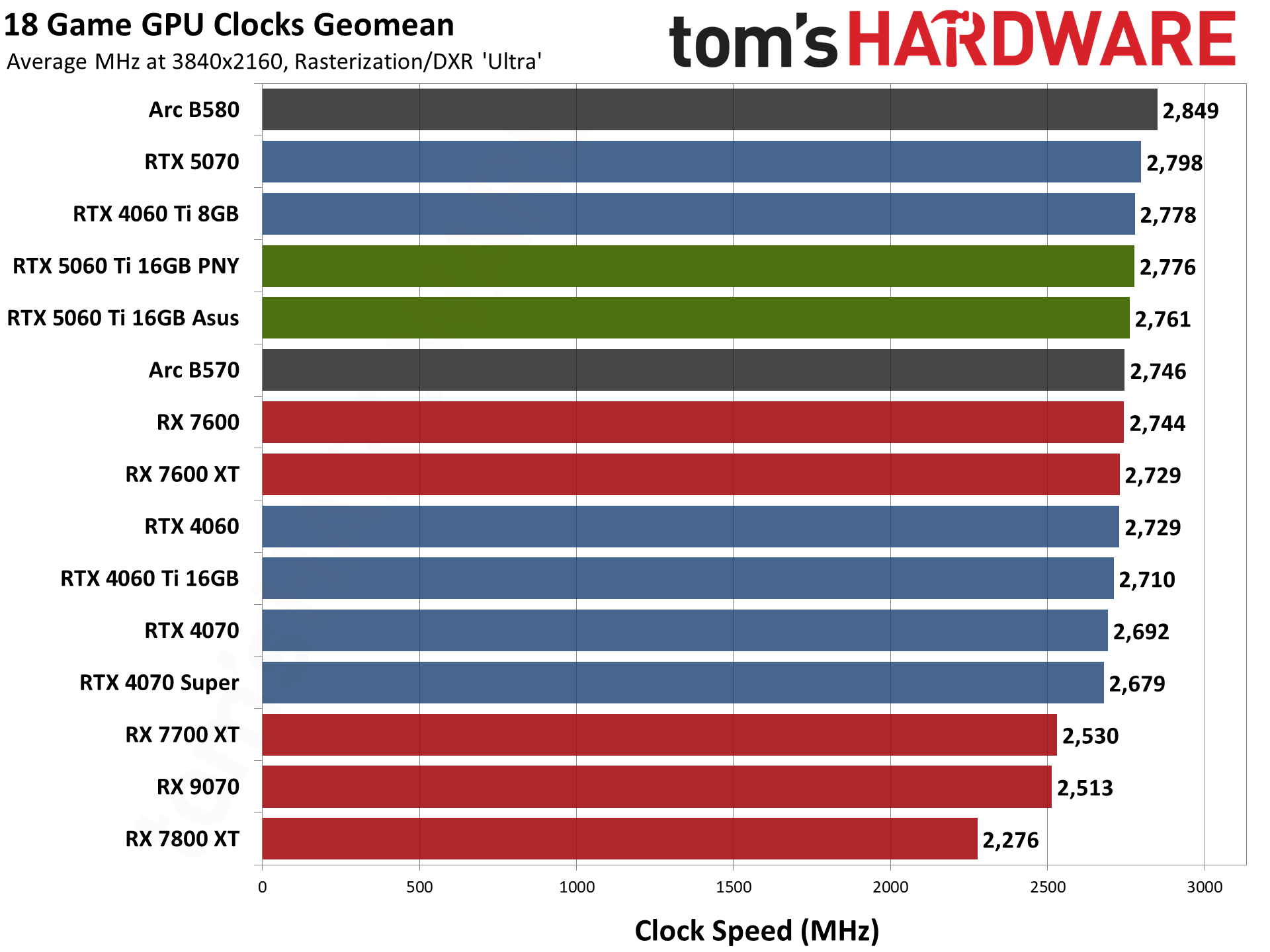

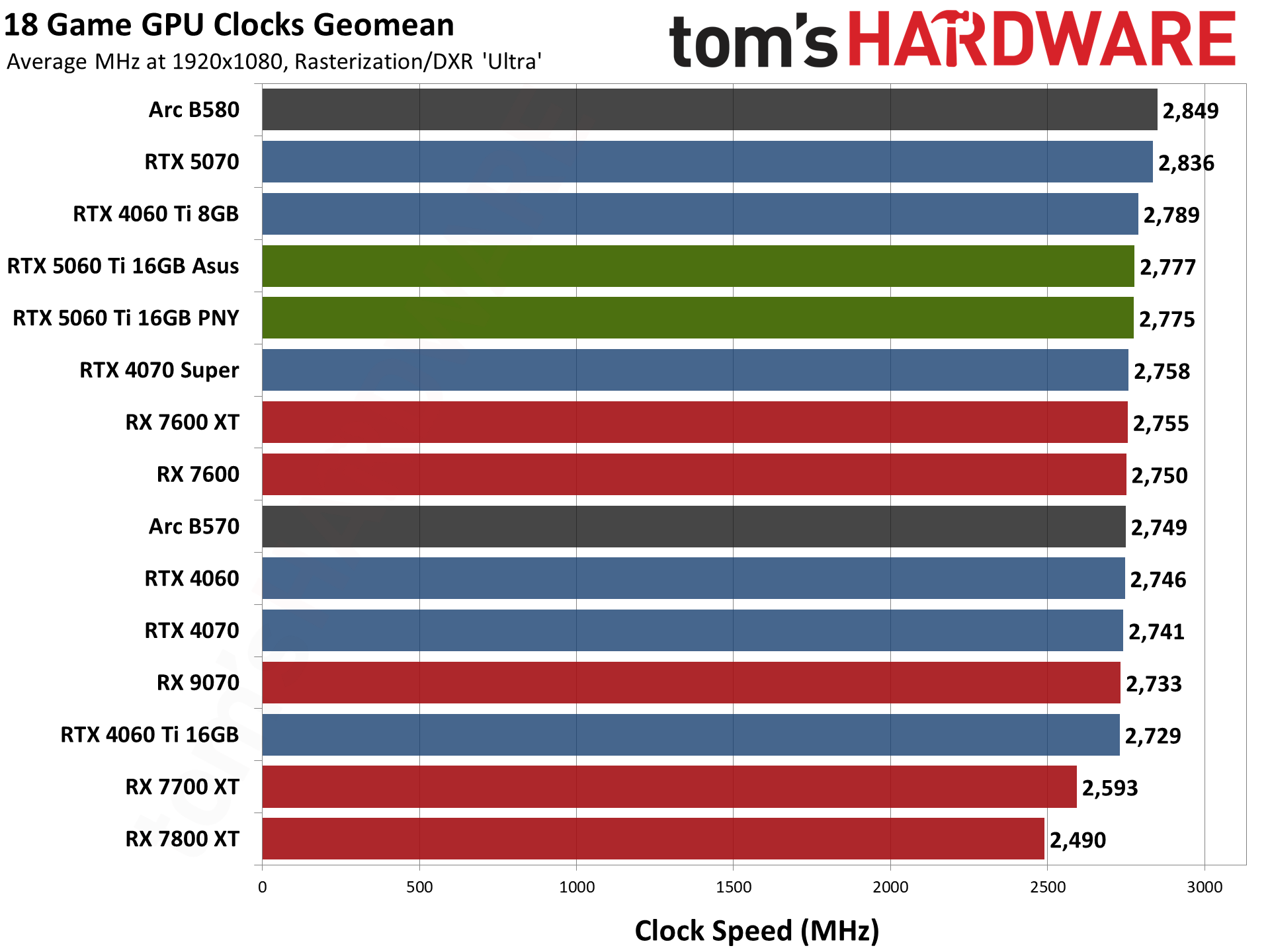
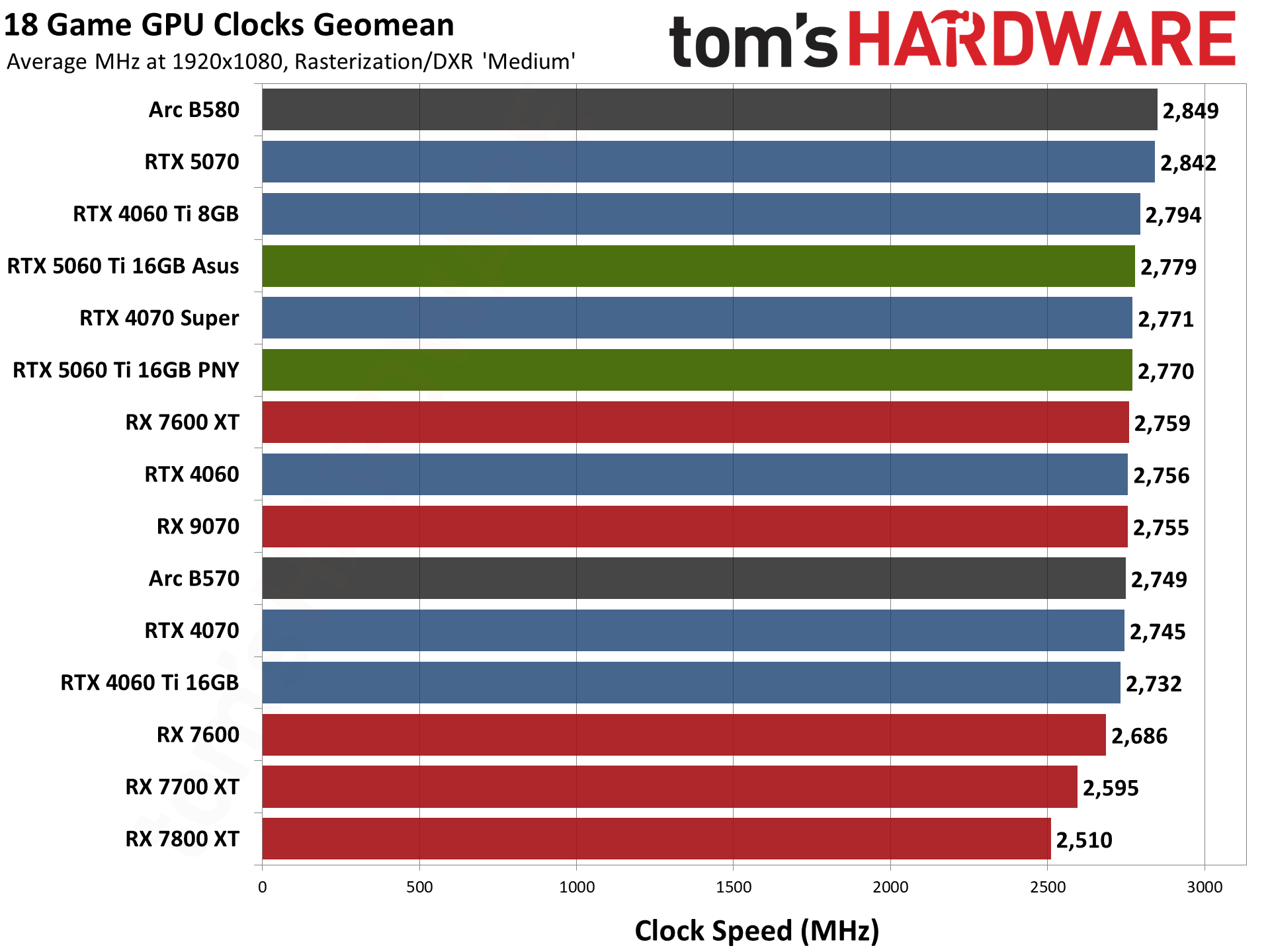
Clock speeds among the different GPUs and architectures aren't super important, but it's still interesting to see where things land. The PNY card does average higher GPU clocks at all of our test settings compared to the Asus card, but both also have slightly lower clocks compared to the 5070 and even the 4060 Ti 8GB. The 4060 Ti 16GB on the other hand drops further down the charts — though we're only looking at a 50–66 MHz deficit at worst.
AMD's RDNA 4 chips can hit very high clocks, at least with the 9070 XT or with overclocking. Out of the box, however, the 9070 power limits keep its clock speeds in check. The RX 7000-series GPUs have quite a large spread as well, with the 7600 series parts basically matching the Nvidia GPUs while the 7700 XT and 7800 XT fall 100 MHz to as much as 500 MHz behind. (The reference 7800 XT seems to clock relatively poorly, due to the card's design.)
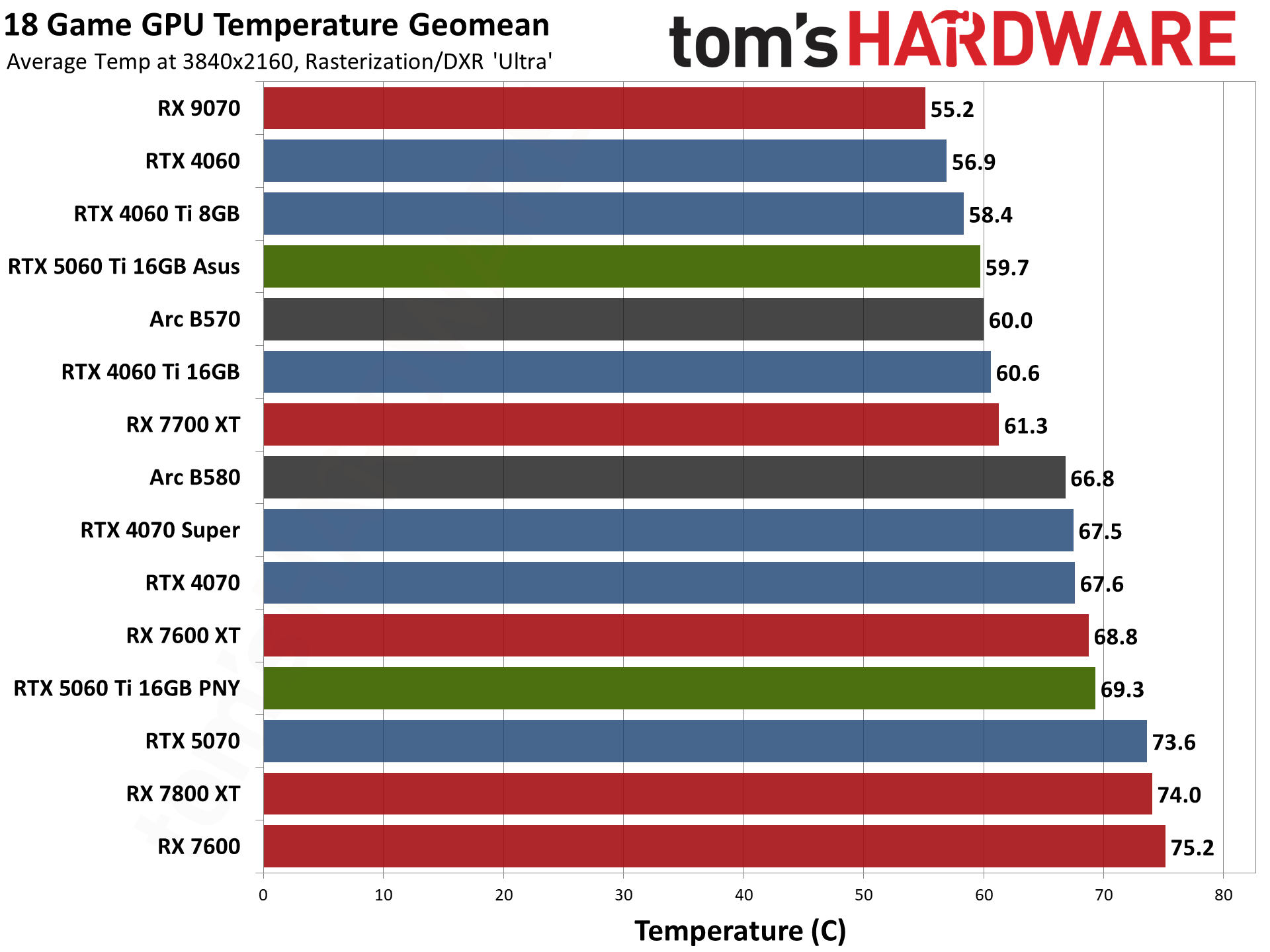
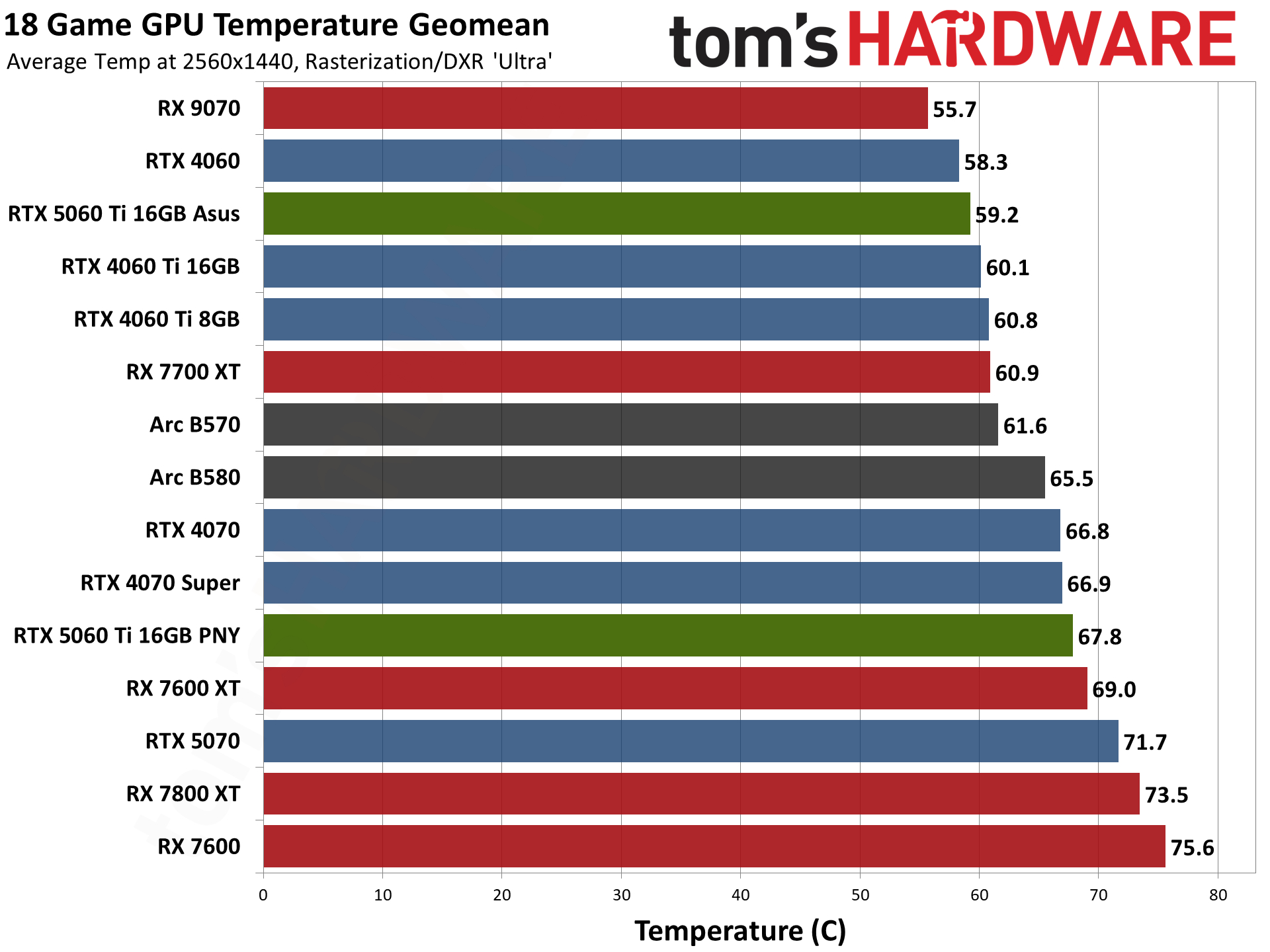
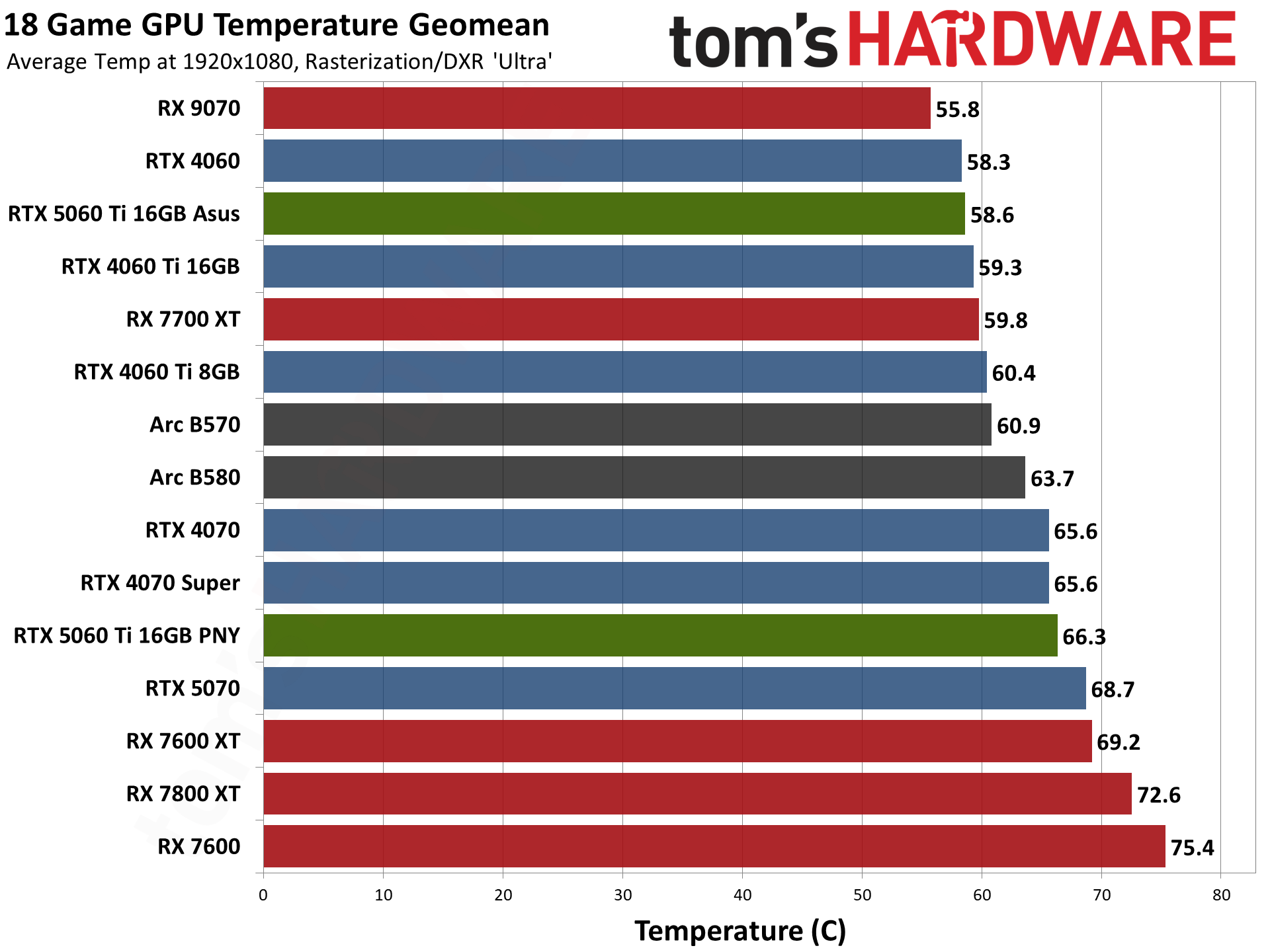
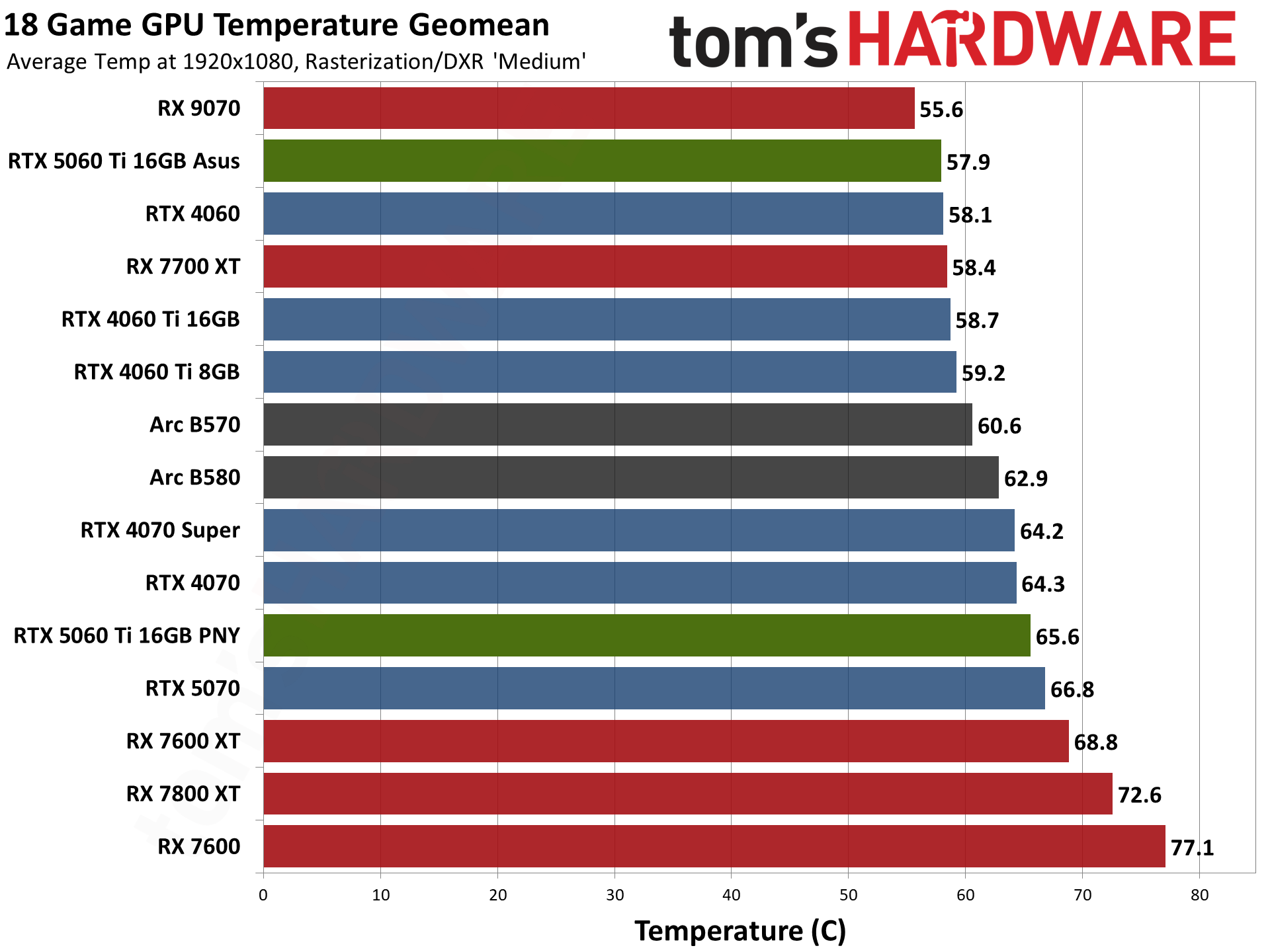
Like the clock speeds, comparing GPU temperatures without considering other aspects of the cards doesn't make much sense. One card might run its fans at higher RPMs, generating more noise while being "cooler." So these graphs should be used alongside the noise and performance results.
While the PNY card often ends up slightly faster than the Asus Prime thanks to a higher boost clock, temperatures clearly favor the Asus design. That's not surprising, since it has an extra fan and a much larger radiator. The Asus design runs 8–9 degrees Celsius cooler than the PNY card, and slightly cooler than the 4060 Ti 8GB/16GB cards.
But we also need to look at noise levels... and we haven't finished retesting every card, so some of the cards aren't in this chart. But the 5060 Ti is!
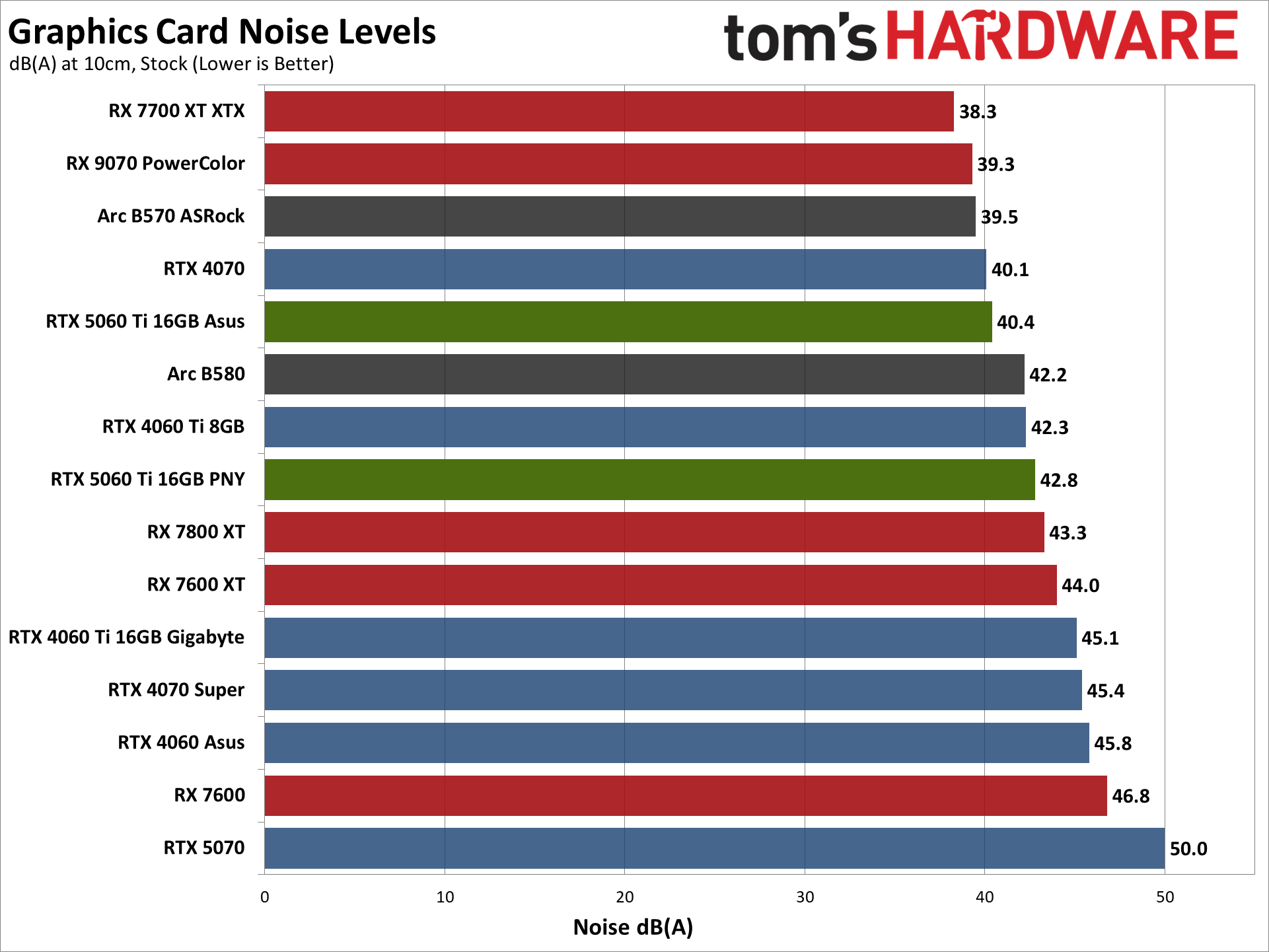
We check noise levels using an SPL (sound pressure level) meter placed 10cm from the card, with the mic aimed right at the center of one fan: the center fan if there are three fans, or the right fan for two fans. This helps minimize the impact of other noise sources, like the fans on the CPU cooler. The new noise floor of our test environment and equipment is around 34 dB(A), due to the noise from the CPU cooling pump.
The Asus card not only runs cooler but is also a couple of decibels quieter than the PNY card. That makes sense, considering the cooler size, fans, and clock speed differences. Having one less fan with a smaller and lighter cooler, with an older fan design, plus higher boost clocks? Yes, that results in a card that makes more noise.
It's interesting to see that, despite the larger form factor and triple fans, Nvidia's own RTX 4070 Founders Edition still manages slightly higher performance overall with less noise. It may not have some of the other extras like a dual VBIOS, and some of the noise gets "hidden" by having one fan on the opposite side of the card, but it's still a good design overall. The large XFX RX 7700 XT also delivers impressively quiet performance, thanks to an even larger cooler and fans compared to the Asus 5060 Ti.
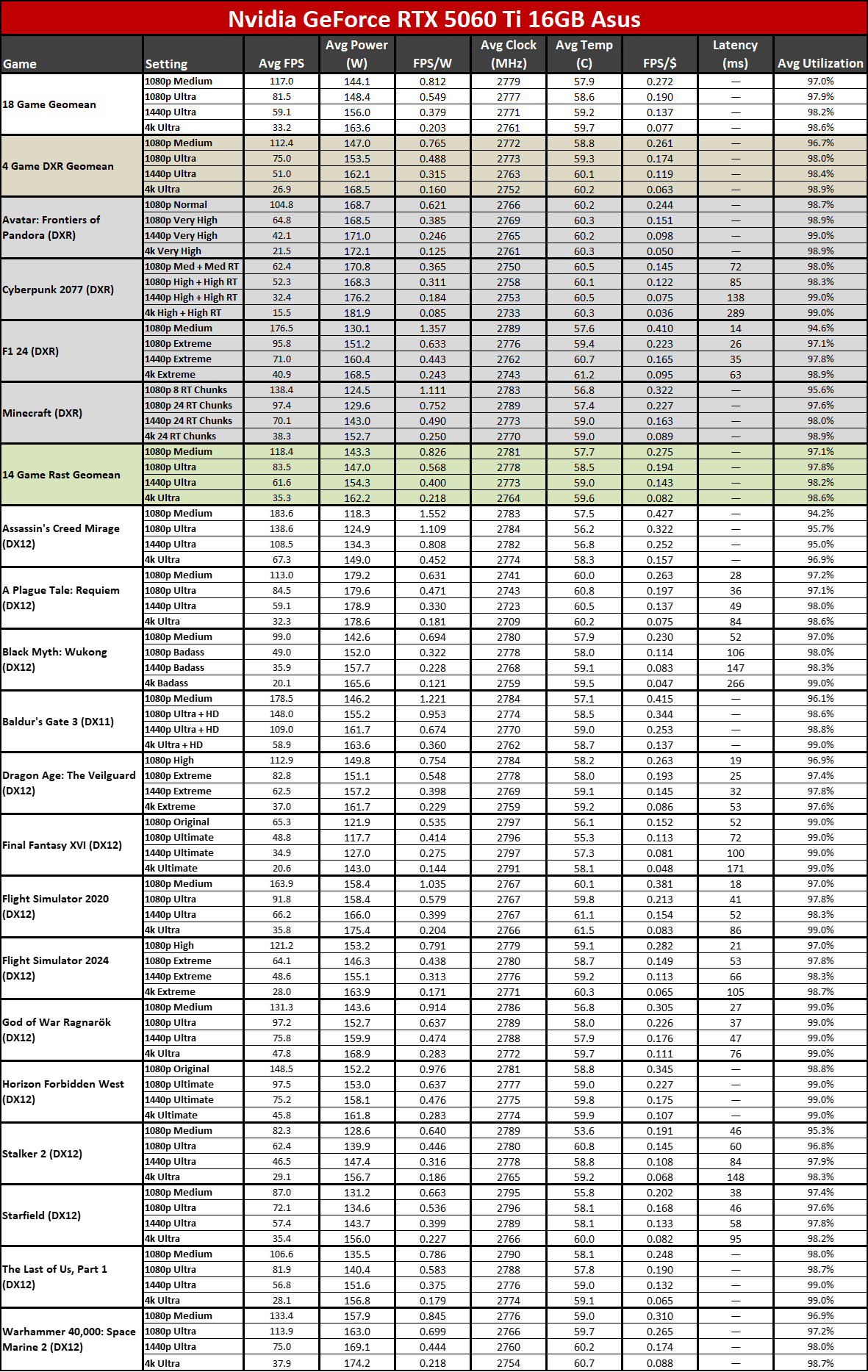
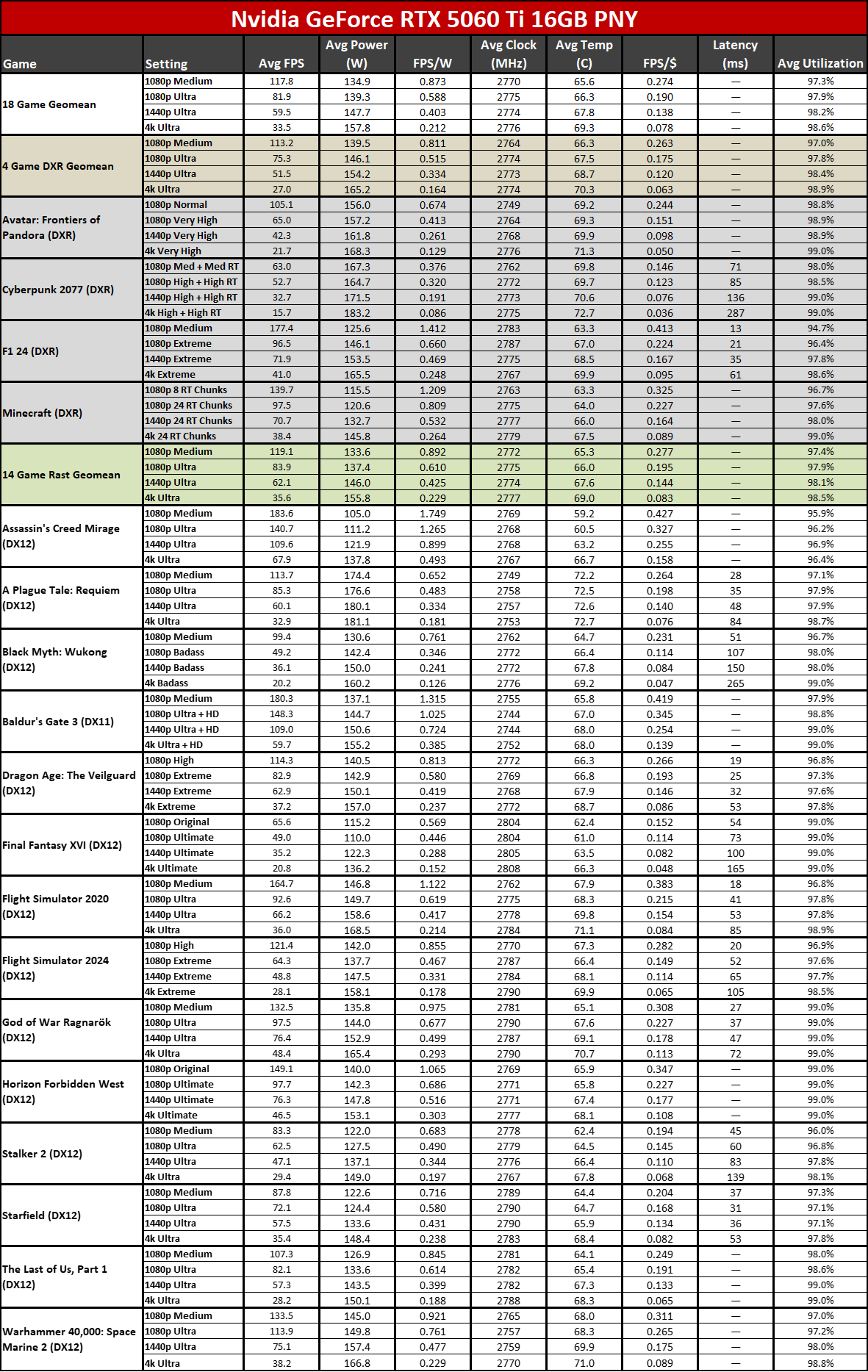

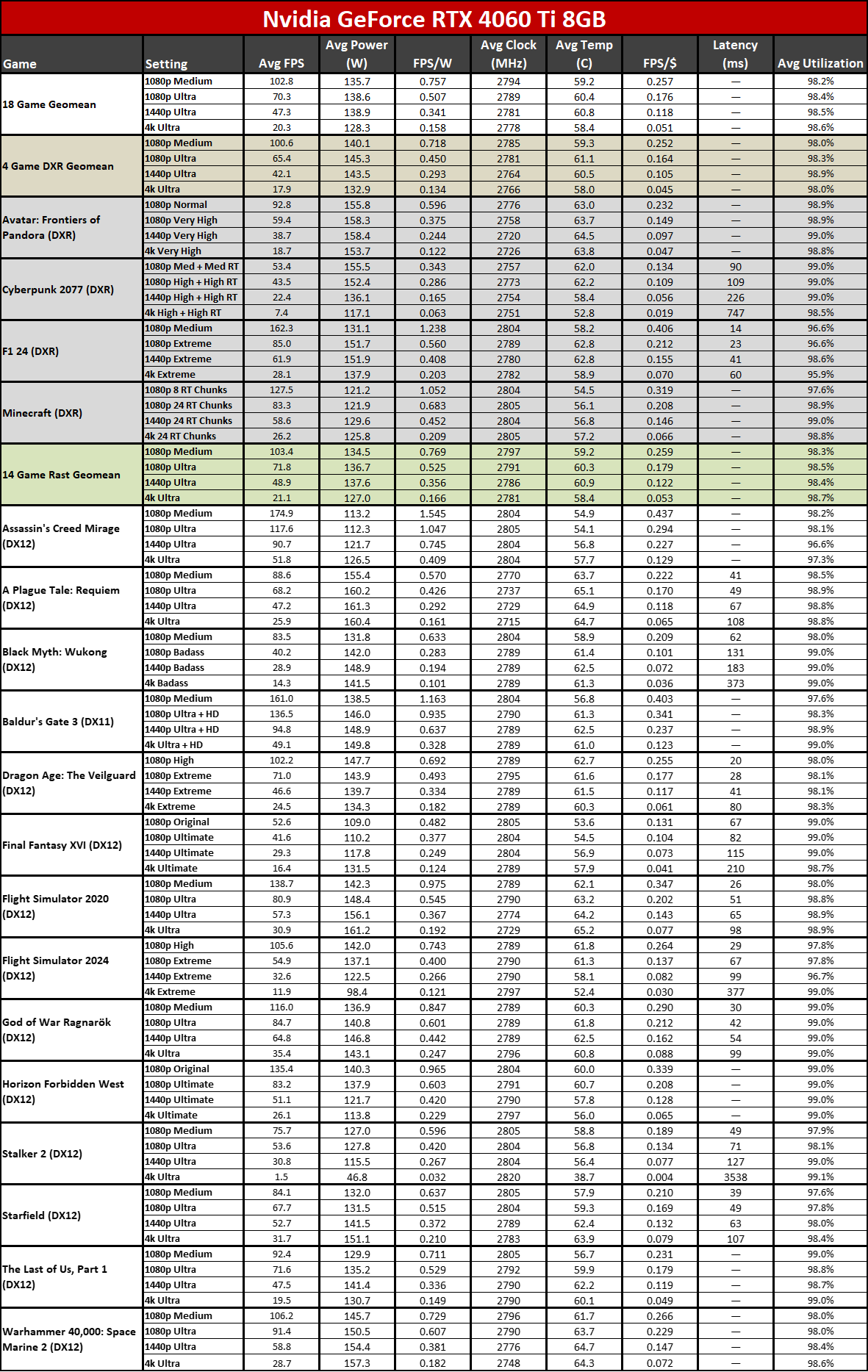
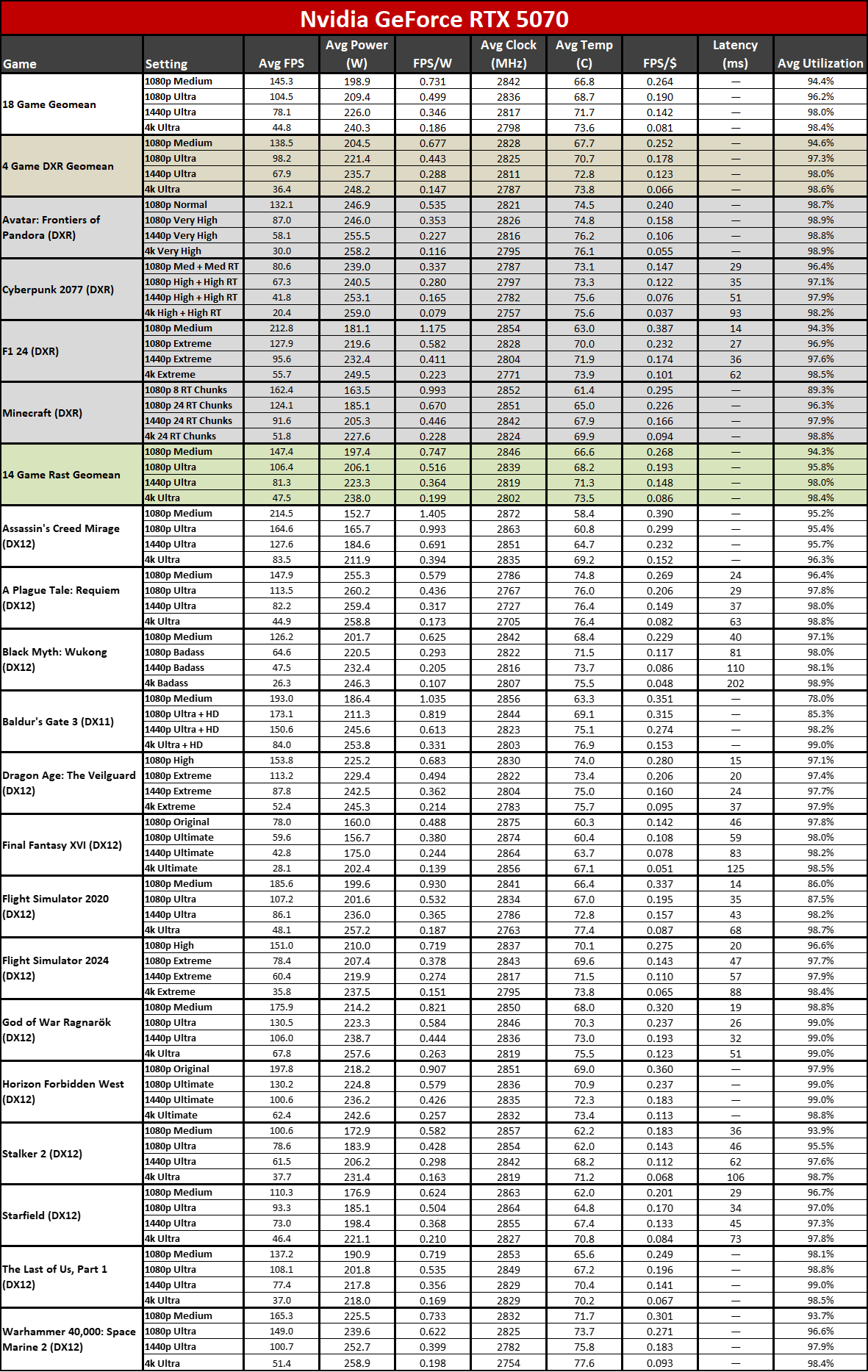
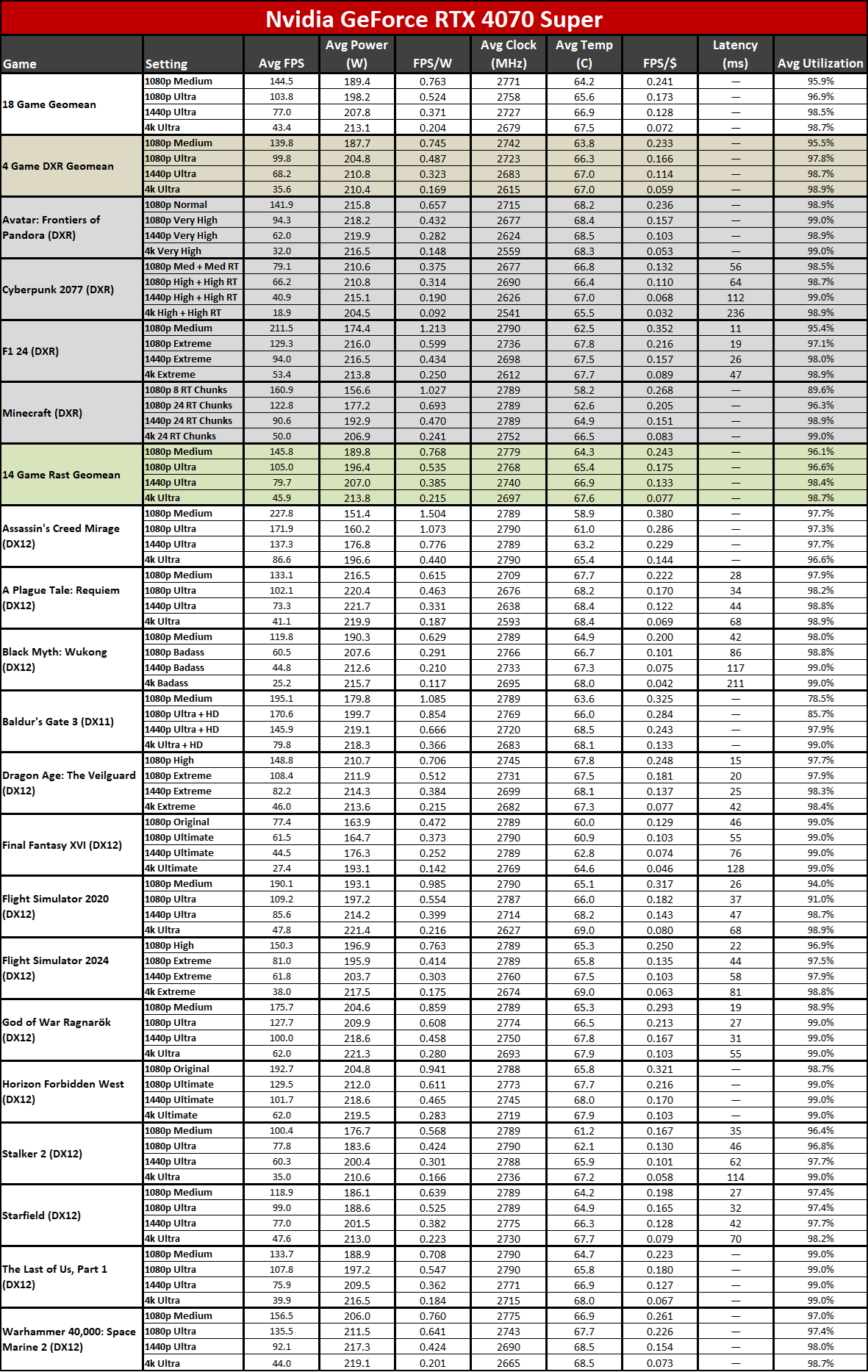
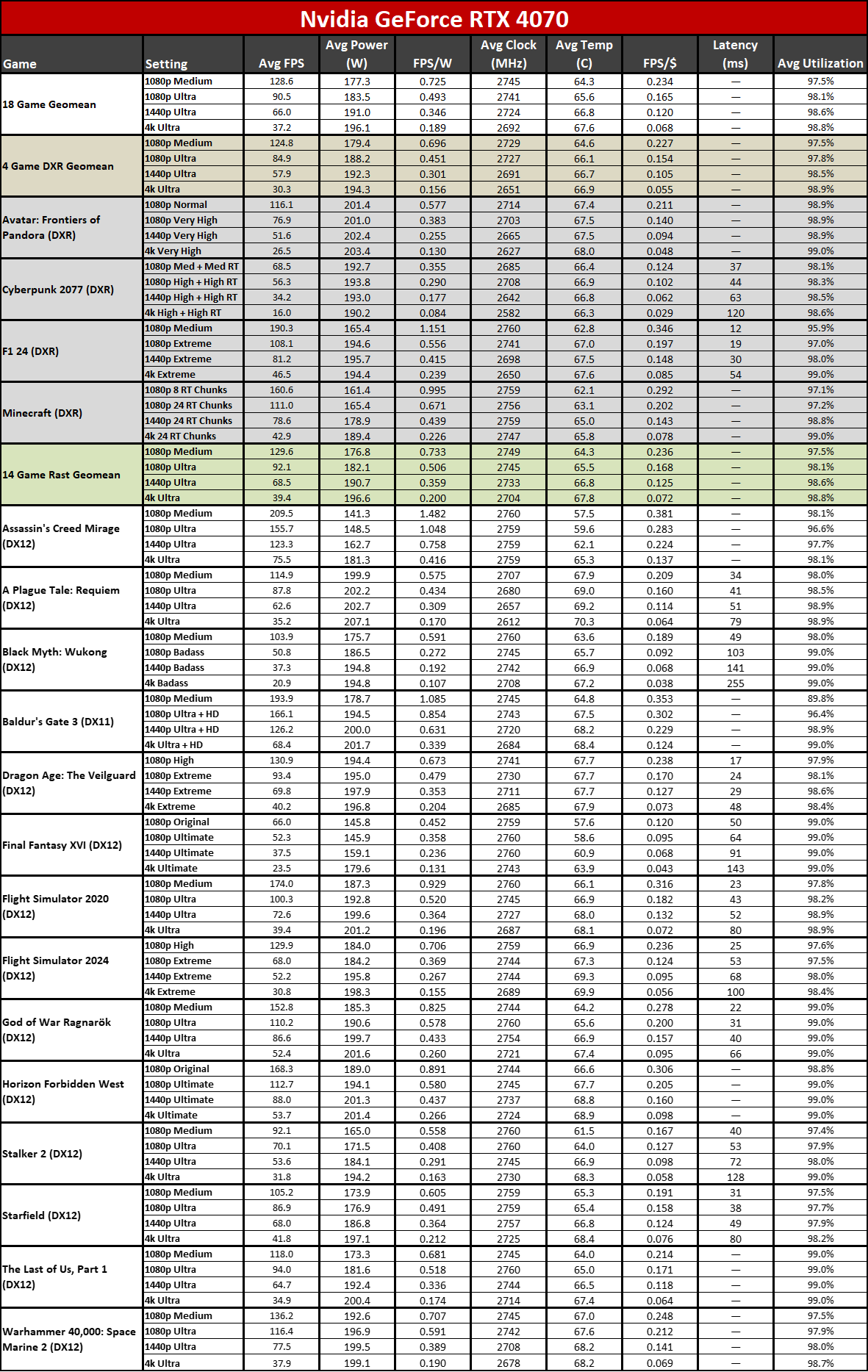
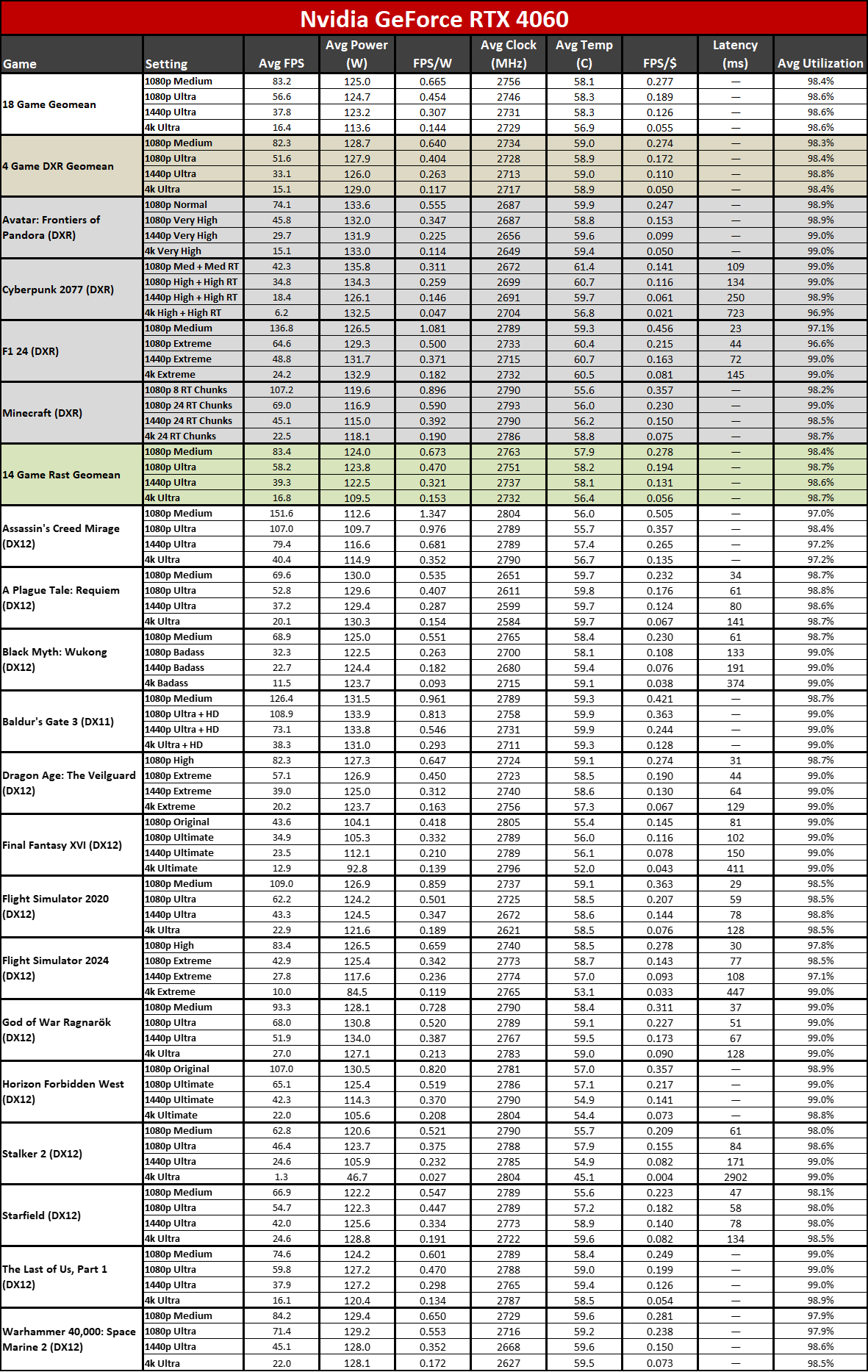
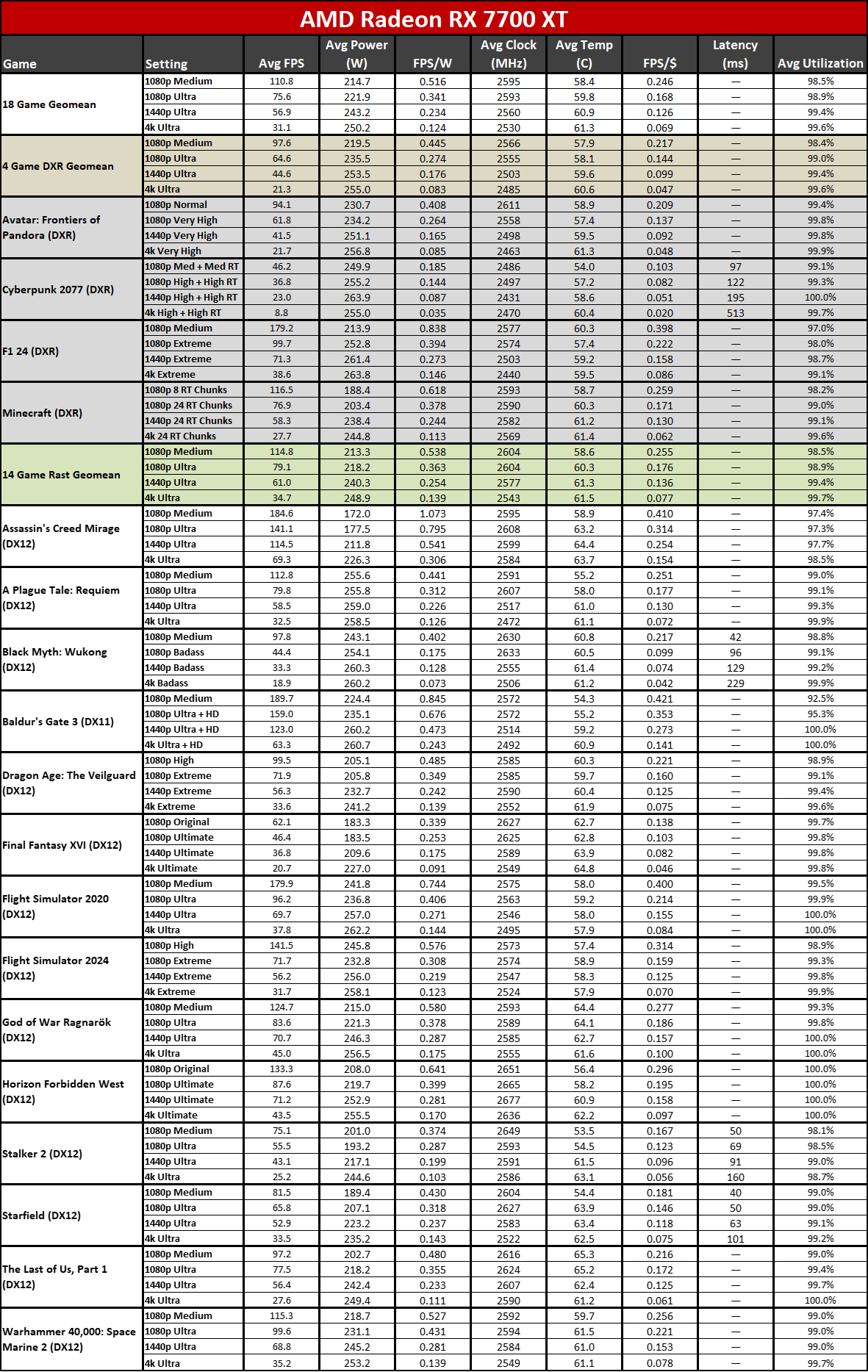
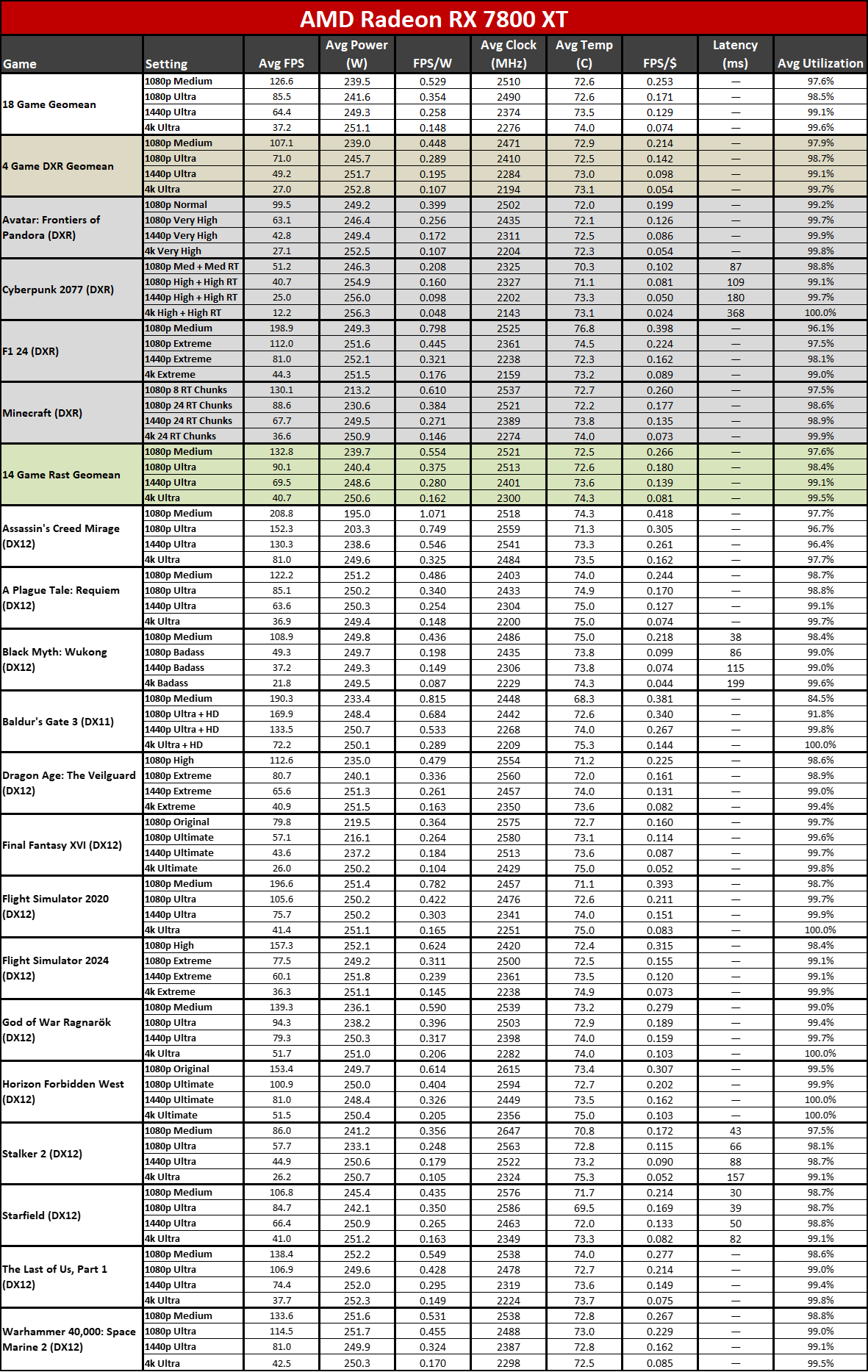
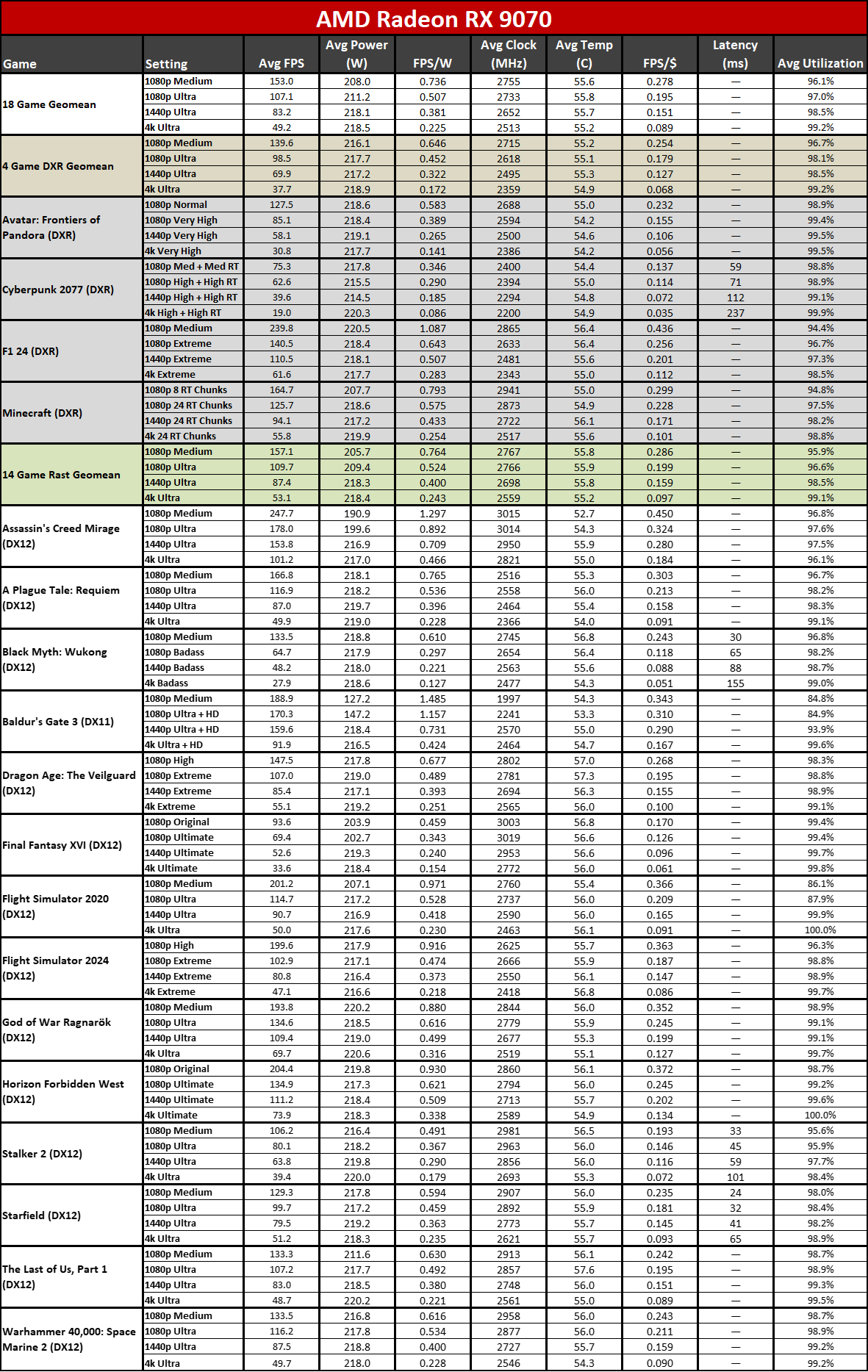
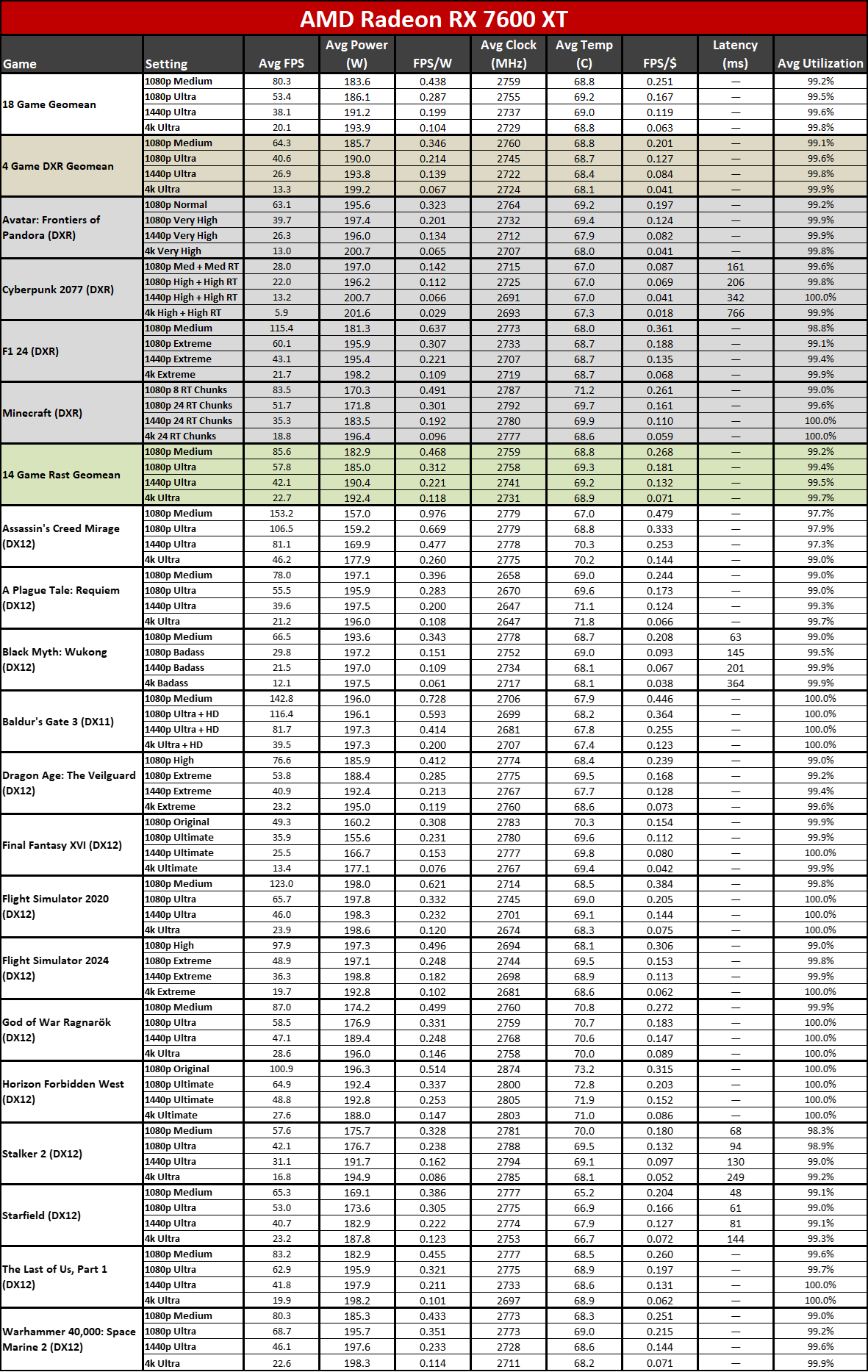

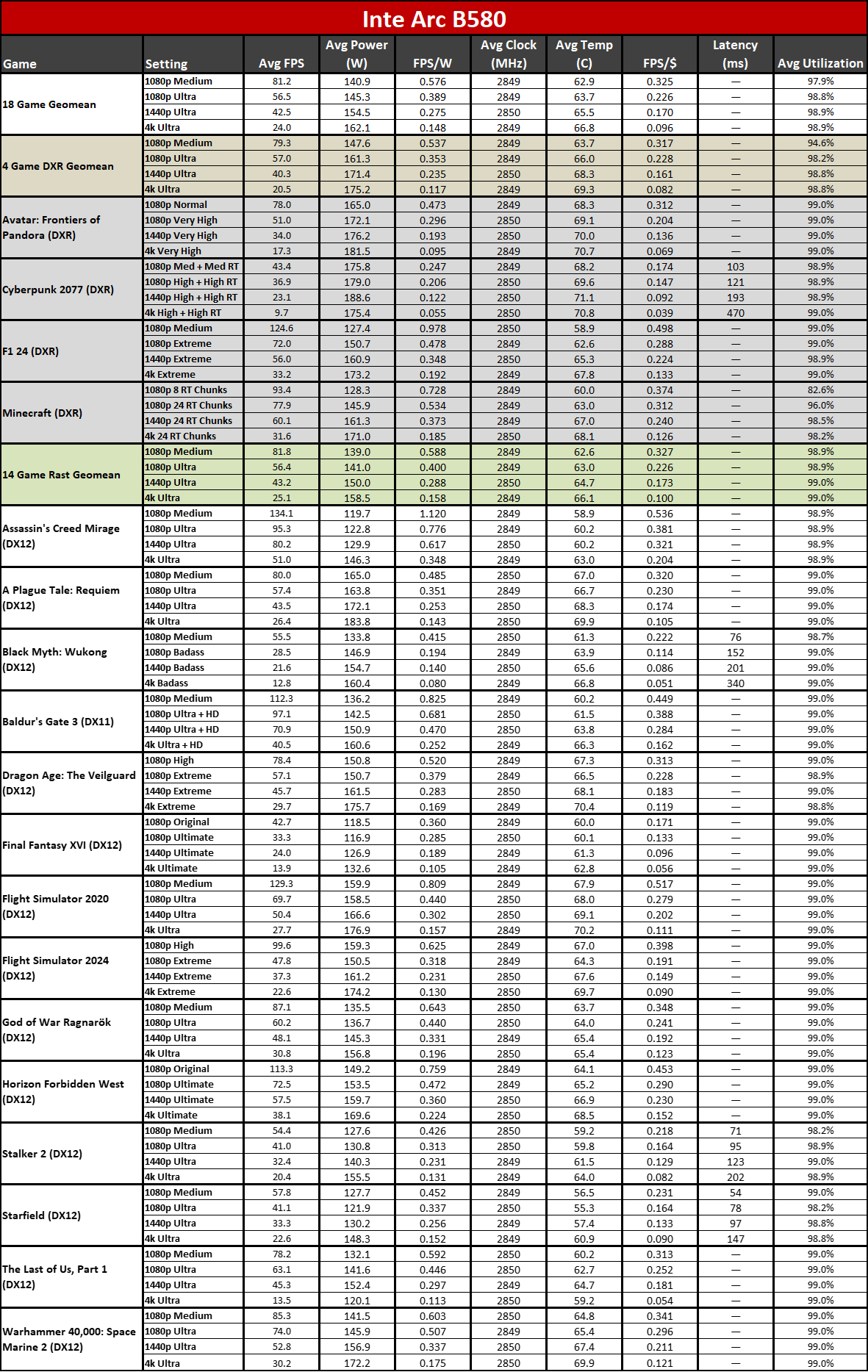
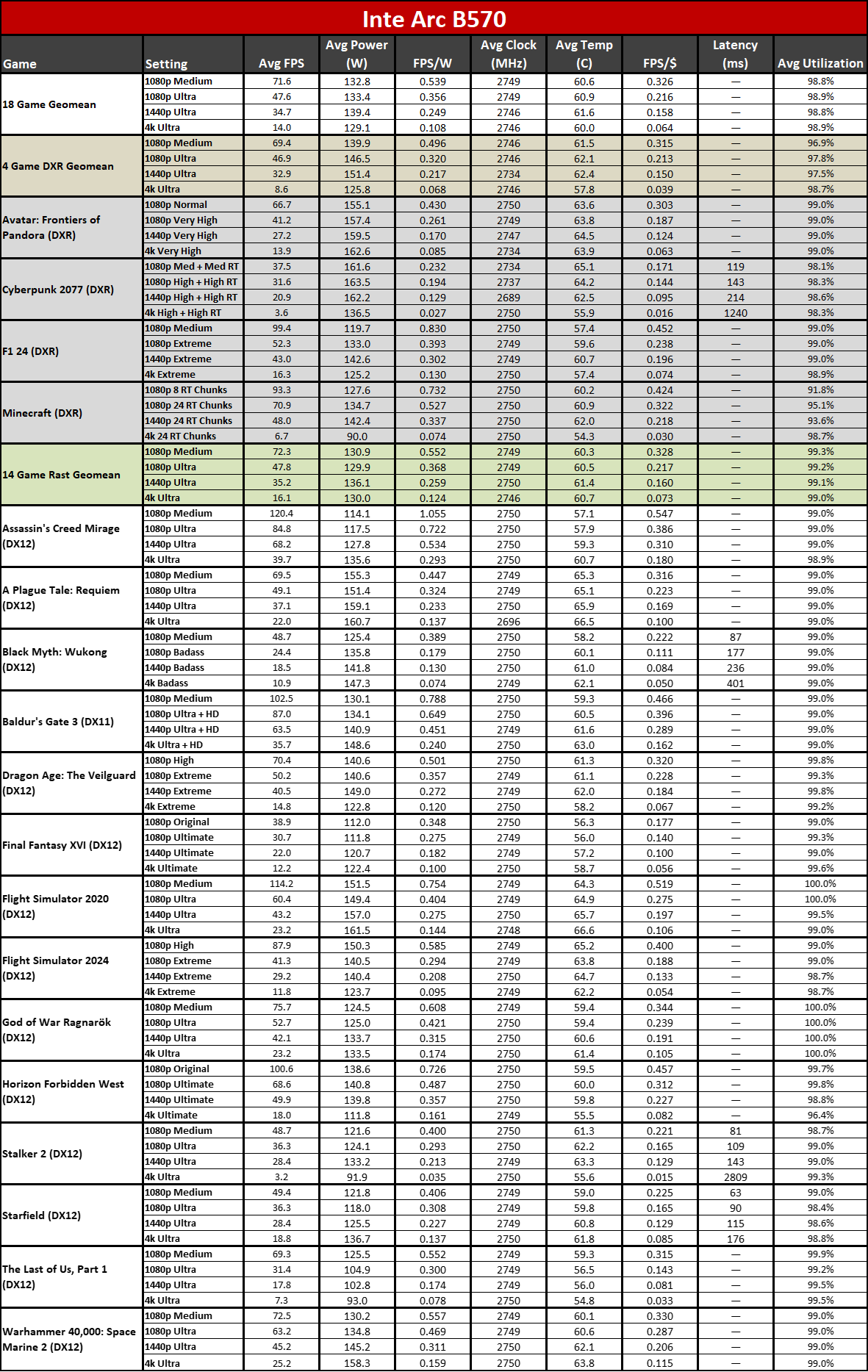
Here are the full tables of testing results, with FPS/$ calculated using the various launch MSRPs for the cards. That's because current retail prices are all wildly inflated, and many of the previous generation GPUs are now discontinued. Any pricing information we put in right now will inevitably be outdated and meaningless, so don't pay too much attention to the "value" column until and unless things calm down. Latency results are included for some of the games as well, and you can see the game-by-game power figures.
- MORE: Best Graphics Cards
- MORE: GPU Benchmarks and Hierarchy
- MORE: All Graphics Content
Get Tom's Hardware's best news and in-depth reviews, straight to your inbox.
Current page: Nvidia GeForce RTX 5060 Ti 16GB Power, Clocks, Temps, and Noise
Prev Page Nvidia GeForce RTX 5060 Ti 16GB Content Creation, Professional Apps, and AI Next Page Nvidia GeForce RTX 5060 Ti 16GB: Great at MSRP, but retail prices could be much higher
Jarred Walton is a senior editor at Tom's Hardware focusing on everything GPU. He has been working as a tech journalist since 2004, writing for AnandTech, Maximum PC, and PC Gamer. From the first S3 Virge '3D decelerators' to today's GPUs, Jarred keeps up with all the latest graphics trends and is the one to ask about game performance.
-
Amdlova I want to say that is a nice card... But with 180w TBP for those numbers it's a waste of sand.Reply
nvidia is afraid to bench the 8GB cards... Just buy an AMD card and be happy -
palladin9479 Once the 8GB model comes out would be nice to see a quick article focusing just on 4060 and 5060 8 / 16 finding the settings where 8GB stops being capable. The 1080p medium graph shows that the 8GB cards work fine at that level, but then the next step is "ultra" which usually has ridiculous texture sizes. Would be nice to see 1080, 1440, 2160 "high" or "very high", one step down from ultra and see how well those cards do. Someone buying a xx60 class card isn't going to have a good experience playing at 4K "ultra".Reply
Amdlova said:nvidia is afraid to bench the 8GB cards... Just buy an AMD card and be happy
It's right in the article just compare both versions of the 4060. Each test has a graph at the very end using 1080p medium and you can see the 8GB model does very well there. They didn't have time to do additional testing with "high" or "very high" intermediate levels and ultra has ridiculously large texture sizes that start to hurt 8GB cards. I see them as doing well on 1080/1440 with "high" settings, basically a budget gamer using whatever they can get their hands on. We laugh but I know a ton of guys like that at work, have wives and kids are upgrade a piece at a time. -
JarredWaltonGPU Reply
In our test suite, 1080p ultra is still playable in all 18 games on an 8GB card, or at least an 8GB Nvidia card. (The RX 7600 may have some issues in one or two games.) There are however games like Indiana Jones where 8GB represent a real limit to the settings you can use. The TLDR is that it varies by game, but 1080p/1440p "high" should be fine on an 8GB card. I'd still pay the extra $50 if I were in the market for this sort of GPU (assuming it's only a $50 difference, naturally).palladin9479 said:Once the 8GB model comes out would be nice to see a quick article focusing just on 4060 and 5060 8 / 16 finding the settings where 8GB stops being capable. The 1080p medium graph shows that the 8GB cards work fine at that level, but then the next step is "ultra" which usually has ridiculous texture sizes. Would be nice to see 1080, 1440, 2160 "high" or "very high", one step down from ultra and see how well those cards do. Someone buying a xx60 class card isn't going to have a good experience playing at 4K "ultra". -
cknobman So the new gen 60 TI class card cant even come close to matching the last gen vanilla 70 class card?Reply
Seems like a really bad "upgrade" to me.
Definitely a 3 star, not 4, kind of score.
Also if you have been keeping up with the news Nvidia is purposely not letting 8gb cards get reviewed.
They told partners they are not allowed to sample those cards out for review.
The only way you will get 8gb card reviews is AFTER release and when they are purchased at retail by reviewers.
The only reason this is happening is because Nvidia knows the 8gb cards are crap. Making reviews wait until after retail availability ensures that at least the first batch will fly off shelves regardless.
Nvidia is a terrible company. -
palladin9479 ReplyJarredWaltonGPU said:In our test suite, 1080p ultra is still playable in all 18 games on an 8GB card, or at least an 8GB Nvidia card. (The RX 7600 may have some issues in one or two games.) There are however games like Indiana Jones where 8GB represent a real limit to the settings you can use. The TLDR is that it varies by game, but 1080p/1440p "high" should be fine on an 8GB card. I'd still pay the extra $50 if I were in the market for this sort of GPU (assuming it's only a $50 difference, naturally).
Yeah it's all price dependent $50 USD to go from 8 to 16 is a no brainer, but there is a large market for older stuff including used cards (see your other article). Steam survey has 1080p being 56.40% of the market with 1440p being 19.06%, that's 3/4ths of the gaming market between those two resolutions. 8GB VRAM was 35.52% with 12GB at 18.42 and 6GB at 11.93%. Over 60% of the market was 8GB or less and only ~7.2% had 16GB or more. We've obviously got a center mass of sorts around 1080/1440 with 8GB, kind of the definition of "mainstream" and why I'm interested in that bracket despite youtubers claiming that a 8GB card can't run solitaire in 2025.
It's not sexy but it's the vast majority of the consumer gaming market and with economies being what they are are prices going up, that market segment wants to squeeze as much out of it's limited disposable income as possible.
I mean RX 7600 8GB at $290 USD. Dirt cheap by todays standards. The poster child of "1080p medium/high".
https://www.amazon.com/PowerColor-Hellhound-Radeon-Gaming-Graphics/dp/B0C48LM7NN/ -
Alvar "Miles" Udell I'd say this is a 3 star card.Reply
Should have knocked a star off just because the 8gb model exists to up charge for the 16gb model.
The 19% rasterization performance improvement deserves another deduction because it is a terrible Gen over Gen increase, same across the 5000 series stack. Yes it's just a refinement generation, but even for MSRP you're talking over $400 for 1080p75/1440p60 in 2025 and not even matching last gens 4070, which will be made all the worse once custom editions tack on their upwards of $100 premiums.
Granted this is an upper entry level gaming card, a PC built around it is still very much more expensive than a console, and needs to have performance that justifies it. -
DRagor I have checked my local market. All 8Gb cards were sold out while 16Gb were still in stock, some even at MSRP (although many had price close to 5070 lol). For me it is clearly foul play by NVIDIA: let the ppl watch 16Gb version reviews and then go buy cheaper 8Gb models coe they're cheapo and ppl don't understand difference.Reply -
Gururu B580s are still in stock... So many similar cards tested from the big two, why not toss in the ARC B580 for buyer options? We know it sits in the 7600/4060 class or higher.Reply -
Roland Of Gilead Reply
Totally agree with you. I was kinda hoping the 5060ti would have a similar bump like the 3060ti did, being faster than a 2080 Super. I kinda figured from the reviews of the new gen 50xx models that it wouldn't really hit the point. But to do so, so unspectacularly is not good.cknobman said:So the new gen 60 TI class card cant even come close to matching the last gen vanilla 70 class card?
As pointed out, the 5060ti 16gb is the only choice for only $50 more. It's a no brainer.
I'm quite happy now with my 4070 Super, and have no FOMO. Well, maybe apart from the 9070XT, which I think is hands down the award winner in the last roll out of GPU's. Defo the stand out card right now, if they are available. -
ThereAndBackAgain Reply
Honestly, if people don't understand the difference between 8 GB VRAM and 16 GB VRAM, they shouldn't be spending $400+ on a GPU in the first place. But it's kind of hard to imagine someone knowledgeable enough to build their own PC not comprehending VRAM. The people who bought those cards most likely knew exactly what they were getting.DRagor said:I have checked my local market. All 8Gb cards were sold out while 16Gb were still in stock, some even at MSRP (although many had price close to 5070 lol). For me it is clearly foul play by NVIDIA: let the ppl watch 16Gb version reviews and then go buy cheaper 8Gb models coe they're cheapo and ppl don't understand difference.
